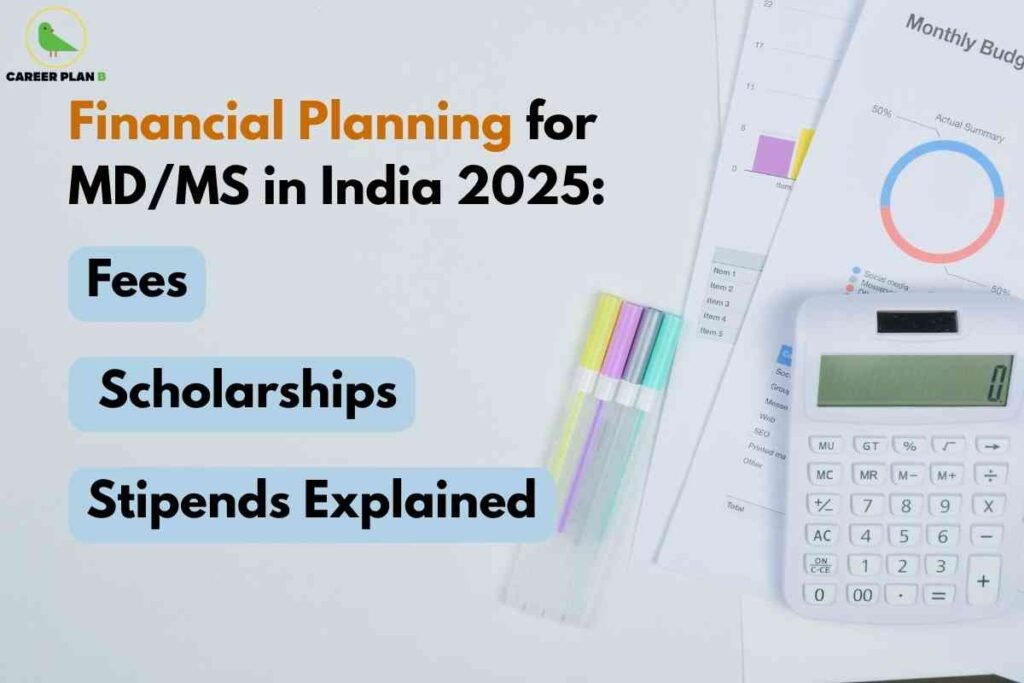Introduction
Cracking NEET-PG or INI-CET represents just the initial milestone in your postgraduate journey. However, effective medical PG financial planning becomes absolutely crucial once you secure admission to your desired program.
The financial landscape encompasses tuition fees, hostel charges, and essential daily living expenses. These costs fluctuate dramatically between government and private institutions. While government colleges provide stipends to ease financial burden, private universities present considerable monetary challenges.
Many aspiring specialists overlook comprehensive medical PG financial planning, resulting in unexpected financial stress during their studies. Beyond basic tuition, expenses include registration costs, examination fees, and additional academic materials.
Strategic medical PG financial planning ensures you concentrate on academic excellence rather than monetary worries. Therefore, understanding complete cost structures, available scholarships, and stipend systems becomes fundamental for every future medical specialist.
Fees for MD/MS Courses in India
The fees for MD/MS courses vary widely depending on whether the institution is government, private, or deemed.
1. Government Medical Colleges
Range: ₹40,000 – ₹2 lakhs for the entire course
Why affordable? Subsidized by the government
Best for: Students who secure top ranks in NEET-PG/INI-CET
2. Private Medical Colleges
Range: ₹15 – ₹40 lakhs for the full course
Variation: Depends on the branch (Radiology and Dermatology cost higher)
Additional costs: Hostel, examination, and clinical training charges
3. Deemed Universities
Range: ₹25 lakhs – ₹1.5 crore (entire course)
Note: Often the most expensive but provide modern infrastructure
Example Breakdown (Approximate 2025 figures):
MD General Medicine (Govt College): ₹1.5 lakh total
MD Radiology (Private College): ₹35–60 lakhs
MD Dermatology (Deemed Univ): ₹80 lakhs – ₹1.2 crore
Scholarships and Financial Aid for MD/MS
Scholarships are crucial for reducing the financial burden of medical education.
1. National Scholarships
Central Sector Scheme of Scholarship – Offered by the Ministry of Education
ICMR/DBT Fellowships – Research-based financial support for medical students
2. State-Level Scholarships
Offered to economically weaker sections, SC/ST/OBC candidates, and minority groups
3. Institutional Scholarships
Some private colleges provide need-based or merit-based fee concessions
4. Bank Loans
Education loans up to ₹50 lakhs, with repayment starting after course completion
5. Overseas Options
International scholarships like Chevening (UK) and Fulbright (USA) for MD/MS abroad
Stipends for MD/MS Residents in India
While PG students pay fees, they also earn stipends during residency to help cover living expenses.
Stipend Structure in India (2025 Averages):
Government Colleges: ₹60,000 – ₹95,000 per month (varies by state)
Private Colleges: ₹25,000 – ₹50,000 per month
AIIMS and INI Institutions: ₹95,000 – ₹1,10,000 per month
Examples:
Delhi (Govt Colleges): ₹90,000/month
Maharashtra: ₹70,000–80,000/month
Karnataka: ₹60,000–65,000/month
Tamil Nadu: ₹55,000–70,000/month
Note: Stipends act as a cushion but often don’t cover full costs in private or deemed colleges.
Fact Table: Average MD/MS Financial Overview (India, 2025)
| Category | Government Colleges | Private Colleges | Central Institutes (AIIMS, PGI, etc.) |
|---|---|---|---|
| Tuition Fees (per year) | ₹40,000 – ₹1.5 lakh | ₹5 lakh – ₹20 lakh | ₹50,000 – ₹80,000 |
| Total 3-Year Fees | ₹1.2 – ₹4.5 lakh | ₹15 lakh – ₹60 lakh | ₹1.5 – ₹2.4 lakh |
| Monthly Stipend | ₹50,000 – ₹1,00,000 | ₹25,000 – ₹60,000 | ₹80,000 – ₹1,00,000 |
| Scholarship Availability | High (Govt. + State Schemes) | Limited (Mostly external) | Moderate to High |
| Living Expenses (per month) | ₹15,000 – ₹25,000 | ₹20,000 – ₹40,000 | ₹20,000 – ₹30,000 |
Smart Tips for Financial Planning During MD/MS
Start Early: Research fees and stipends while preparing for NEET-PG
Set a Budget: Estimate tuition, hostel, books, and living costs
Use Stipends Wisely: Save part of your stipend instead of spending it all
Consider Education Loans: Take loans with moratorium periods that allow repayment after PG
Explore Scholarships: Apply early; deadlines can be strict
Plan Specialization Costs: High-demand branches like Radiology, Dermatology, and Orthopedics often cost more
Transparent Fee Information: Updated details across government, private, and deemed universities
Scholarship Guidance: Identifies scholarships you may qualify for and assists with applications
Loan Support: Guides you in approaching banks with the right documents and repayment strategies
Stipend Comparisons: Offers state-wise stipend insights for better decisions
Backup Planning: Suggests affordable alternate options if high-demand specialties are unavailable
With Career Plan B, financial planning becomes a structured part of your PG journey, not an afterthought.
Have any doubts?
📞 Contact our expert counsellor today and get all your questions answered!
FAQs
Q1. How much does it really cost to complete MD/MS in India?
It depends on the type of college. Government colleges may charge as low as ₹2 lakhs, while private and deemed universities can go up to ₹1 crore or more.
Q2. Do all MD/MS students get stipends?
Yes, government colleges provide stipends. Private colleges also pay, but the amount is usually lower.
Q3. Can stipends cover my tuition fees?
No. Stipends are meant for living expenses. Tuition fees must be arranged separately.
Q4. What is the highest stipend offered in India?
AIIMS and other central institutes offer the highest stipends, often above ₹1 lakh per month in 2025.
Q5. Are scholarships available for MD/MS in private colleges?
Yes, but they are limited. Most scholarships are government or state-funded, and private aid depends on the institution’s policy.
Q6. Can I get an education loan for MD/MS?
Yes. Most banks provide loans up to ₹50 lakhs with repayment starting after course completion.
Q7. How can I reduce the financial burden of pursuing MD/MS?
Apply for scholarships, choose government colleges if possible, and use stipends wisely. Career Plan B can guide you in identifying the best financial strategies.
Conclusion
Successful medical PG financial planning requires systematic preparation and comprehensive research. Government institutions offer economical pathways with stipend advantages, while private colleges demand substantial financial investment.
Start scholarship applications early, explore education loans with competitive interest rates, and maintain emergency funds for unforeseen expenses. Many students achieve their specialization dreams through disciplined financial management and strategic resource utilization.
Remember, specialized medical education represents a valuable long-term investment in your professional future. However, making informed financial decisions today eliminates unnecessary stress throughout your postgraduate journey. Plan methodically, research extensively, and select options matching both career aspirations and financial capabilities.
Your medical PG financial planning directly impacts your academic focus and overall success in achieving specialization goals.



